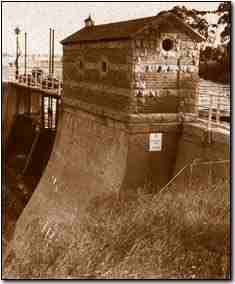| Vaalharts Storage Weir | |
|---|---|
| Location | South Africa |
| Coordinates | 28°06′54″S24°55′30″E / 28.115°S 24.925°E Coordinates: 28°06′54″S24°55′30″E / 28.115°S 24.925°E |
Vaalharts Storage Weir is a dam in South Africa. It was established in 1936. Vaalhartz Weir (alternative spelling) is located on the Vaal River approximately 100 km downstream of Bloemhof Dam and 13 km upstream of Warrenton. The main purpose of the dam is to divert water from the Vaal River (released from Bloemhof Dam) to the Vaalhartz Government Water Scheme as well as the Barkly Government Water Scheme. Water is also used for numerous small towns including Vryburg, Hartswater, Jan Kempdorp, Warrenton, Winsorton, Kipdam, Barkly West and Delportshoop.

South Africa, officially the Republic of South Africa (RSA), is the southernmost country in Africa. It is bounded to the south by 2,798 kilometres (1,739 mi) of coastline of Southern Africa stretching along the South Atlantic and Indian Oceans; to the north by the neighbouring countries of Namibia, Botswana, and Zimbabwe; and to the east and northeast by Mozambique and Eswatini (Swaziland); and it surrounds the enclaved country of Lesotho. South Africa is the largest country in Southern Africa and the 25th-largest country in the world by land area and, with over 57 million people, is the world's 24th-most populous nation. It is the southernmost country on the mainland of the Old World or the Eastern Hemisphere. About 80 percent of South Africans are of Sub-Saharan African ancestry, divided among a variety of ethnic groups speaking different African languages, nine of which have official status. The remaining population consists of Africa's largest communities of European (White), Asian (Indian), and multiracial (Coloured) ancestry.

The Vaal River is the largest tributary of the Orange River in South Africa. The river has its source near Breyten in Mpumalanga province, east of Johannesburg and about 30 kilometres (19 mi) north of Ermelo and only about 240 kilometres (150 mi) from the Indian Ocean. It then flows westwards to its conjunction with the Orange River southwest of Kimberley in the Northern Cape. It is 1,120 kilometres (700 mi) long, and forms the border between Mpumalanga, Gauteng and North West Province on its north bank, and the Free State on its south.

Bloemhof Dam is a dam in South Africa. It was originally known as the Oppermansdrif Dam when under construction during the late 1960s. It is located at the confluence of the Vaal River and the Vet River, on the border between the provinces North West and Free State. The dam wall has a total length of 4,270 metres (14,010 ft) The reservoir is very shallow, and therefore needs a large area to mean anything for water storage. The area around the reservoir (dam), has been a protected area, but because it lies on the border between provinces, these became two separate nature reserves. On the North West Province side lies the Bloemhof Dam Nature Reserve, on the Free State side is the Sandveld Nature Reserve.
The main construction of the weir was completed in 1938 and was part of the government initiatives to alleviate unemployment following the depression of the 1930s.
In 1967, the weir was raised by 1.2m to its current height of 11m. It is a concrete barrage-type structure, 765m wide with numerous sluices. The sluices are of two types; some for the normal river releases and some for flood management purposes. The dam is designed to handle floods of up to 14200 m³/s.
After the raising of the dam in 1967, it has a storage capacity of 45 million m³. It diverts water into a concrete lined canal on the right flank with a capacity of 40 m³/s. This canal supplies water to approximately 37000 ha of irrigation, most of which is located in the Vaalhartz and Barkly Government Water Schemes.













